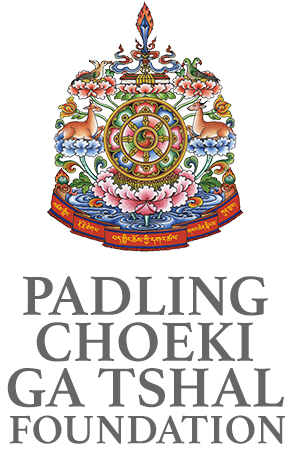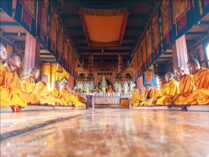Foundation of the Monastery
In the 15th century, in around 1440 AD, A Buddhist Saint (Drupthop) Thangtong Gyalpo also known as Chagzampa came to Bhutan from Tibet and meditated at Paro Taktshang. While at Taktshang, Drupthop met with Drupchhen Kagye in person and also met with the local deity of that site, the nine headed serpent demon who told him to discover the dharma treasure that Guru Rinpoche had hidden in that place destined to be his share.
The Great Drupthop discovered a treasure of rolled paper of around 20 meters that contained the summarized contents of all the sutras and mantras. After that, Drupthop Thangtong Gyalpo went to India and visited Chhoeten Namdhagdrung where he offered prayers with profound aspirations. He received vital pith instructions from the Great Saints of India, transformed into Dorje Jiggyed and subdued the spirits of the dead bodies (zombies) and the evil spirits.
After returning from India and before going back to Tibet, Drupthop came to Bhutan and constructed many Buddhist temples at the sacred sites and installed the religious relics of body, mind and speech (Ku-Sung-Thukten). He constructed many iron bridges for the sacred sites and across many large rivers in the country. He also established countless retreat centers which greatly benefited the sentient beings at large. It was told that, Chitokha Monastery is one among the monasteries built by Drupthop Thangtong Gyalpo in the early 15th Century.
The Chitokha Monastery taken over by the second Gangteng Incarnate (Trulku) Tenzin Legpai Dhondrup
The Second Gangteng Trulku Tenzin Legpai Dhondrup completed his three year retreat meditating Lama Norbu Jamtsho and Personal Sacred Deity (Yidam) such as Vajrapani (Chhagna Dorje), Vajrakilaya (Dorje Phurpa) etc. He also completetd Tsalung Thrulkhor of Dzogchhen Kunzang Gongdue. He thought of again going into meditation for another few years but due to the outbreak of Tibetan war of Yuetsang led by Desi Tsangpa, Trulku had to discontinue his meditation. At that time, Lam Tenzin Legpai Dhondrup received an edict (Kasho) from the central Government directing him to go to Punakha. In Punakha, Lam performed an elaborative avert ritual against the Tibetan army which led to the easy victory by then third Druk Desi Chogyel Minjur Tempa. The Desi, as a gesture of gratitude, offered the Trulku with cultivating land, horses and a flour mill from the place known as Legkhabi (Lenkhebji).
When the Trulku was 37 years old, Gyalsey Tenzin Rabgye told him that the Buddhist Abbots and Teachers (Lams and Lopens) like him have no winter residence for which the Gyaltshab asked to choose any portion of land within the Sha Valley to construct the monastery. To that, Trulku chose Sha Chitokha Monastery which was earlier offered to Zhabdrung Pema Thinley by Drupthop Chagzam Choeje and the Legkhabi offering farm land”. So, as offered by Desi Tenzin Rabgye along with all the properties with much appreciation and happiness, the second Gangteng Trulku Tenzin Legpai Dhondrup took over this Monastery and the offering farm land at Lenkhebi.
Construction of the Monastery
The second Gangteng Trulku Tenzin Legpai Dhondrup thought of constructing a Buddhist Monastery for the promotion of Buddha dharma and for the benefit of all sentient beings and arrived at Chitokha in 1862 which presently serves as a winter residence of the Gangteng Lineages. It is located in between Nyisho and Kazhi village under Wangduephodrang District (Dzongkhag). Thereafter, coinciding with an auspicious day of Guru Rinpoche, the 10th day of the 12th month of Bhutanese calendar of the Wood Dog Year, he laid the foundation stone of the Temple (Tsuglagkhang) after performing all the Astrological formalities like chasing evil spirits (Gegtred), ground breaking ceremony etc. Then, started the works of constructing the temple in a similar way Guru Rinpoche started construction of the majestic Samye monastery in Lhasa, Tibet.
The full responsibility of the construction was entrusted to Lama Shacha and Gelong Jamtsho who acted as a work supervisor and the construction designer respectively. The main responsibility of the masonry works were taken up by the monk masons from Sha Chongsekha and Nyishokha. Likewise, the responsibility of the carpentry works were taken up by Jama Trashi and Tshewang from Jakar; and Tenzin and Dhongag from Punakha. Starting from the ground floor door, they completed the entire carpentry work within three years.
The wall paintings in temple were all carried out by Chhoeje Pema Lama & Lopons from Bumthang and the great religious painter Lhundrup Dorje from Neyphu. In the main temple, they painted the painting of eight manifestations of Guru Rimpoche (Guru Tshengye), story of Lake Sindhu, Eight knowledge holders (Rigzin Ged) of India etc. along with the Tendze. The main wall paintings in the Buddhist temple (Lhakhang) are Sixteen Arhats (Neten Chudruk) and the painting of the Buddha of three generations (Past, Present and future).
Upon the completion of the construction of the temple including the installation of the inner religious relics of the temple, the name of the monastery was given as Phuntsho Rabten Ling. As per the oral tradition, it is being said that the Shrine room (Tsangkhang) of the temple has a peculiar feature where in the hot summer, the cool air flows in and in the cold winter the temperature remains moderate.
Renovation of the Monastery
Because of bad omens of the general people and the worldly sentient beings, almost all the wall paintings of the temple were damaged by the earthquake that occurred in Wood Horse Year. However, the main religious relic of the temple (Lhakhang), the statue of the Buddha of three generations remained un-destructed and can still be seen today.
At the age of 77, Lam Rinpoche returned to the monastery and with great aspiration and intention renovated the temple into a perfect shape in order to preserve and promote the Buddhism and as source of well-being and happiness for all sentient beings. During its renovation, Lam Rinpoche sat into a magical meditation where he left a clear footprint on the foundation stone of the temple and it can be still seen today which serve as one of the sacred religious relics of the monastery. Thereafter, the Second Druk Gyalpo Jigme Wangchuk carried out the construction and renovation of several palaces and monasteries in the country which included Chitokha monastery too which was renovated in 1964. His Majesty found that the monastery was deteriorated almost to completeness after long been constructed for which His Majesty initiated the major renovation of the monastery to preserve the sacred religious monuments present in the monastery. It was renovated by a group of skilled construction experts led by the painter (Lhadrip) named Tau Tau maintaining the relics of the monastery untouched.
Renovation of the Monastery by the ninth Gangteng incarnate (Trulku) Kunzang Rigzin Pema Namgyal
The monastery on top of its existing structural degradation, the earthquake of 2011 had put more damages to its structure. Only the inner relics (Nangten) were left un-destructed. In order to preserve and promote the spread of Buddhism in the country especially the old Buddhist tradition of Nyingma School of Buddhism of six articles of greatness; and uphold the doctrine of Pema Lingpa’s Concealed Treasures (Pedling Terchoe); and as a winter residence of Gangteng lineages, the ninth Gangteng reincarnate (Trulku) Rigzin Pema Namgyal decided to reconstruct the temple. Trulku Rinpoche reported the need of reconstruction of the monastery to the Government and accordingly, the relevant government officials led by the Hon’ble Minister Lyonpo Mingyur Dorji visited the monastery and studied thoroughly.
In 2013, coinciding with the 11th month of Water Snake Year, Gangteng Trulku Rinpoche conducted a Tshogbum (hundred thousand offering ritual) of Pedling Lama Norbu Jamtsho as a ritual of shifting the religious relics of the temple which represented body, speech and mind. Rinpoche also conducted an empowerment of longevity (Tshewang) to the public and discussed about starting the reconstruction of the monastery.
From the 3rd month of Male Horse Year in 2014, under the wise leadership of Gangteng Trulku Rinpche, the administrative and management team of Buddhist teachers (Lopons) who graduated from Gangteng Dhongag Thoesam Dargye Ling College of Buddhist Studies dismantled the old structure from the base and currently the temple is under the execution of reconstruction works.
Annual Ritual Activities of the Monastery
Since Bhutan is a Buddhist country enriched with religion and culture, the annual rituals activities such as performing offerings to the Triple Gem (Konchosum) and the protective deities are being conducted in every Fortress (Dzongs), Temples (Lhakhangs) and Monasteries for the purpose of peace and prosperity in the country. Likewise, at Chitokha also the annual ritual activities are being conducted right from its initial establishment until now without a single miss. On every 10th and 25th day of a month yar-ngo and mar-ngo (first & second half of the lunar month), the feast offering (Tshokhor) ritual of Pedling Thukdrup Lama Norbu Jamtsho is conducted. Lama Tenzin Legpai Dhondrup, Vajra Master (Dorje Lopon) and most of the lay Buddhist practitioners (Gomchens) used to return to their winter residence at Chitokha after conducting the tribute offering on the 24th of the 9th month at Gangteng San-ngnag Chhoeling Goenpa leaving behind only the Sungkhorp, Kunyer, Kangjup (Kangjupa) and the care taker. Besides the regular ritual activities, on the 14th of the 10th month, the monk body performs the ritual offerings to eight groups of local deity Mahakala (Ngoentok Goenpo Degey). Along with the shifting of the monastic community to their winter residence the community people of Gangteng also moves for winter settlement at Chitokha. From 25th to 29th of the 11th month, the monks read the complete set of Buddhist Canon (Kangyur) coinciding with the auspicious days of Winter Solstice. After full preparation on the 23rd and 24th day of the 11th month of Bhutanese calendar before start of the new year, the monastic community on 30th of the 11th month performs feast offering ritual of eight groups of protective deities (Goenpo Degey Tshokhar) after which the lay Buddhist practitioners (Gomchens) leaves for a month long vacation. The Gomchens return from the vacation on the 24th day of the 12th month and prepares for the Annual Jampal Shinjey Shedpo’s ritual to be performed from 27th to 29th day of the same month. The 30th day is called the day of offering to Triple Gem (Konchok) of the village where the villagers gather and stay at the monastery for the entire day of offering serving meals to the ritual performers.
The Buddhist practitioners at Chitokha perform fasting retreat (Nyungney) from 14th to 16th days of the first Buddhist month. The lay Buddhist practitioners (Gomchens) return to Gangteng from Chitokha after the completion of 10th day religious festival (Tshechu) and ritual of offering to Dharma Protector (Choesung Tangra) on the 14th day of the second Buddhist month. Religious rituals during auspicious days such as Lord Buddha’s Parinirvana (Duechen Ngadzom) in the 4th month, Treldha Tshechu in the 5th month, First Sermon of Lord Buddha (Drup Tshezhi) in the 6th month and Descending day of Lord Buddha (Lhabab Duechen) are performed annually.
Inner Religious Relics of the Temple
The majestic statue of Guru Rinpoche made of clay, the statues of the eight manifestations of Guru Rinpoche (Guru Tshengay) and the footprint of the second Gangteng Trulku left on the foundation stone of the temple serve as the main inner relics of the monastery. Other religious relics includes the statue of Avaloketeshra with thousand hands and thousand eyes (Chenreyzig Chhagtong Chentong) constructed by the seventh Gangteng Trulku Tenpai Nyenged, the statues of Bodhisattvas (eight close sons), complete sets of Buddha’s translated texts (Kangyur and Tengyur) procured by the 16th Je Khenpo, His Holiness Sherap Singye. The statues of the Buddha of three generations placed inside the shrine room (Tsangkhang) of the temple is another sacred religious relics worshipped and devoted by many visitors and local people.


